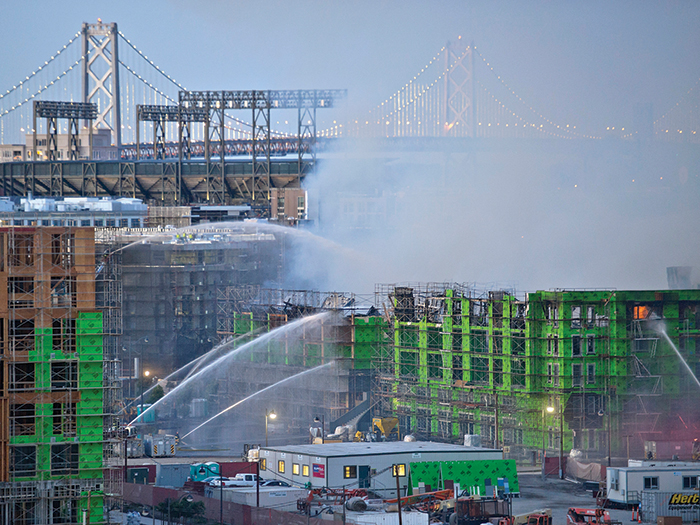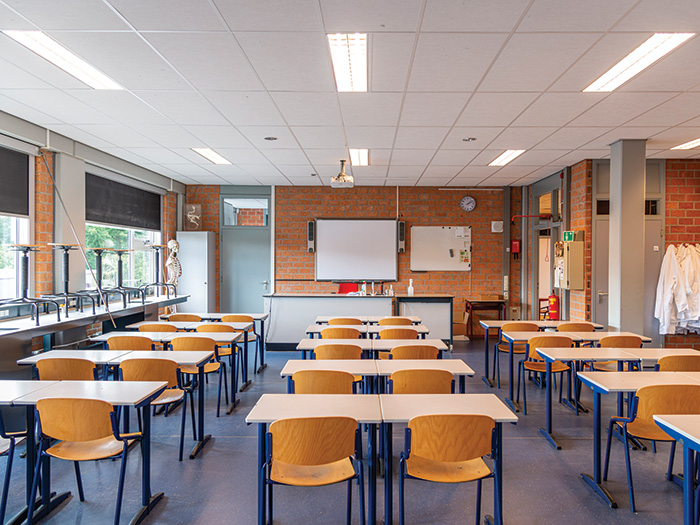Construction Industry
Hot Targets: Upscale Urban Projects

Earlier this year, a pair of spectacular fires just weeks apart, the first in San Francisco and the second two weeks later in Houston, highlighted the perils of a new trend in residential construction: the mid-rise luxury apartment complex.
In both cases, dramatic aerial images showed roiling flames and a thick column of black smoke towering over each city’s downtown as the fires completely destroyed the projects that were still under construction.
What the images did not show were many streams of water directed on the fire. That omission was not for lack of capability.
San Francisco authorities said half of the city’s firefighters on duty were at the scene on March 11, while the Houston Fire Department has a national reputation for aggressive attacks and fast stops.
Video: A wood-frame fire roared in San Francisco in March
But in both cases, there was no life or personal property at stake, and the uncompleted multi-story timber construction gave the fire a head start, lots of fuel, and few impediments to growth.
In such situations, crews often target their efforts at protecting nearby structures, according to loss-control experts and firefighting sources.
“These sites are very tight,” said Ryan Scheinfeld, president of national construction at Technical Risk Underwriters (TRU), part of Ryan Specialty Group, based in Chicago.
“These are more dense than the garden apartments of recent decades, and there is pressure to build quickly. Most of the contractors are experienced and careful, but by their nature these [wood-frame] projects are just more volatile than other modes of construction.
“And because of the higher combustible load, incidents go from incipient to catastrophic in very short order.”
Such construction projects are usually worth much more than the single-family homes or low-rise garden apartments that they replace, and are often on an expedited construction schedule.
Due to the increase in the use of wood framing in such projects, the National Fire Protection Association (NFPA) and other industry groups are reviewing risk mitigation standards and best practices. Many underwriters are doing the same.
Urban Trends
Converging economic and demographic trends known as the new urbanism are combining to increase the size and number of such mid-rise high-end projects, according to underwriters.
“We average 500 to 600 projects a year,” Scheinfeld said.
“The boom in downtown luxury housing includes mixed-use neighborhoods with upscale supermarkets, megaplex cinemas, retailers, and health centers,” he said.
“We write builders risk for large, wood-frame multi-family projects all across the country.”
“If people did what they know they are supposed to do we would not have these problems.” — Rich Luongo, executive property specialist, Chubb
With such developments “going up everywhere,” Scheinfeld said, “the law of numbers says the losses will be where there is activity.”
Not only are these projects more volatile, they are more valuable.
“Developers are moving from the spread, garden-style to a podium style. We call this urban infill. It varies greatly from city to city based on zoning and existing density, but the pronounced trend is to high luxury in wood frame,” he said.
Based on industry estimates, a city-block-sized garden apartment development can have 30 to 60 units and be worth $20 to $35 million. A townhouse development on the same parcel can go up four or more stories plus basement, have hundreds of units, and be worth $100 million.
Loss Prevention
Rich Luongo, executive property specialist at Chubb, is encouraged that fire-protection groups are reviewing their standards and recommendations, but said that best practices are still care and diligence.
“This is basic blocking and tackling,” he said. “If people did what they know they are supposed to do we would not have these problems. As the senior person in loss-control for Chubb, I walk the buildings we write all the time. We work both top down and bottom up. If we see problems, we make critical recommendations.”
A complicating factor in supervision is that there are multiple operators on any site, Luongo said.
“There is the general contractor, the project manager, the subcontractors, and often subs can get lost in the shuffle.
“The No. 1 thing is a regulation hot-work program, a fire watch and a three-hour post-work monitoring,” Luongo said. “No hot-work late in the day, especially on Fridays, or on windy days. Quick debris removal and housekeeping. No smoking on the job site — absolutely, positively, never. But go to any job site and you will find butts on the ground.”
On a positive note, he said that “industry and standards groups are aware there is a trend in this construction, and are starting to respond.” The NFPA recently issued a new standard targeted at fire protection during welding, cutting and other hot work.
A Collaborative Effort
The key for insurers when it comes to risk-transfer implications on wood-frame projects is to eradicate hazards and minimize exposures through a loss prevention approach with clients from the outset, said Sam Whitnell, construction and engineering underwriter with Canopius Managing Agents Ltd. in London.
“As insurers, we try to remove what we can by way of risk, but also control those risks which we cannot remove through loss prevention programs such as material handling, housekeeping on site, fire protections and security outside of normal working hours to prevent incidents such as arson.
“This is achieved through site inspections once framing begins, but there has to be a willingness on the contractors’ part to work with insurers and safeguard against any possible threats. This ultimately ensures successful completion of a project, which is the common goal for all parties involved, including financiers.”
Starting early in the process is important, said Gary Keith, vice president of engineering standards at FM Global.
“Construction is a very vulnerable phase. We work very closely with insureds to ensure that protection systems keep pace with construction.
“Fire protection systems can be installed piece by piece or section by section; they do not have to be installed all at once late in the project. Fire protection has to be managed with the construction schedule regardless of the construction materials or methods,” he said.
FM Global also urges insureds to collaborate with local responders on pre-incident planning.
“The fire inspector is not going to be the one arriving at 3 a.m. on a Sunday,” said Keith. “The local fire commander should know where the job site and building access points are, especially as they change through the project. They have to know where the water supply is.”
At the research level, “we are heavily involved in field operations,” said Keith. “We are comparing existing engineering standards and best practices to what we are finding in the field for all types of projects.
“We understand that clients may want to take advantage of new techniques or trends in construction. We can deal with them directly on a project-by-project basis. But then we work back through our system and check our processes as necessary. We want to take into account model codes and real life.”
That work has led to improved protection systems, and modular approaches to fire protections for projects through all stages of construction.
“There are some major research projects under way right now, in research and testing, and we hope to see some findings and results soon,” said Keith.
“But the most important thing is for protection to maintain pace with the project.”
Scheinfeld noted that TRU gets involved in projects even before construction starts, and is “very active in loss control. We are on each site multiple times to be sure that NFPA standards are enforced.”
In a small irony, Scheinfeld said that aside from catastrophic loss from fire, the second most common loss for these types of projects is from water.
“They often happen late in the project. The first model units are finished, and there is a leak in the line to the dishwasher. A quarter-inch line can leak a lot of water over a weekend.”










